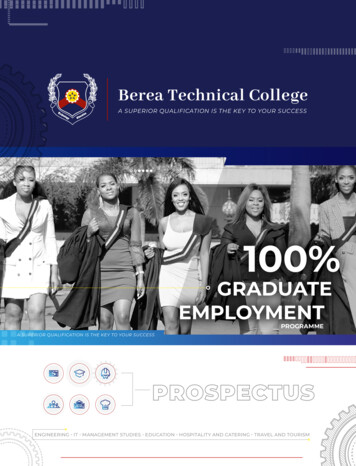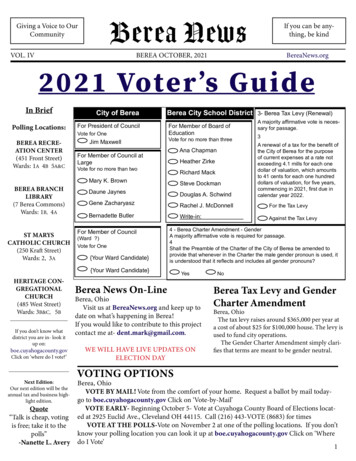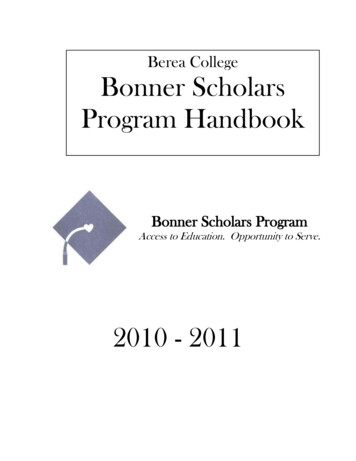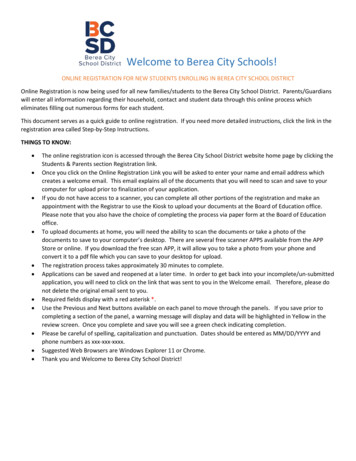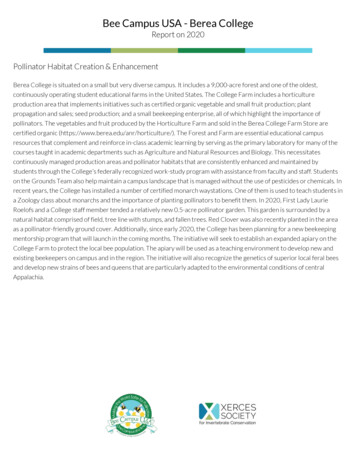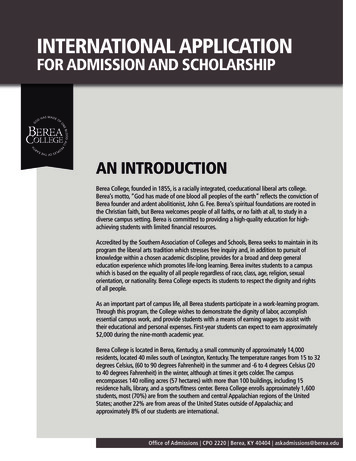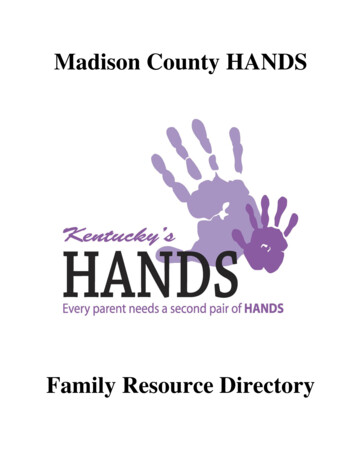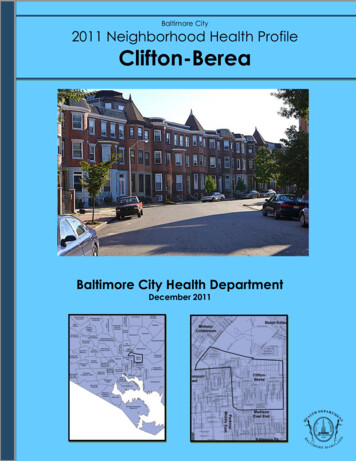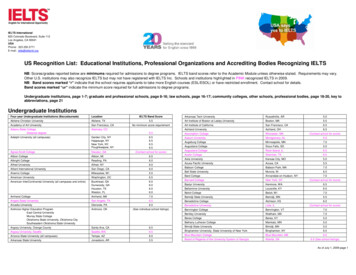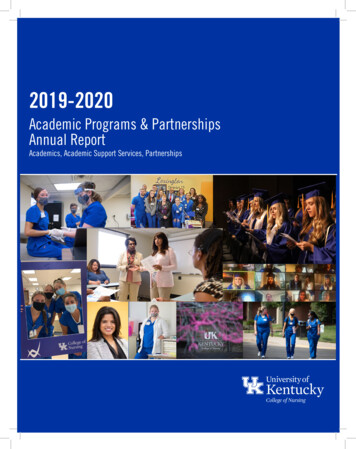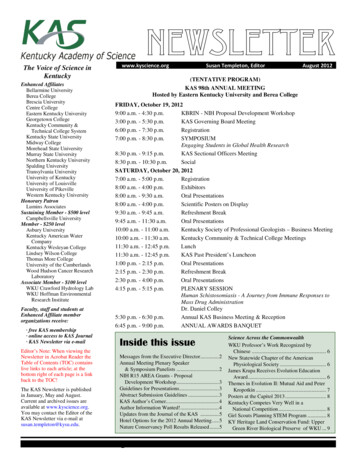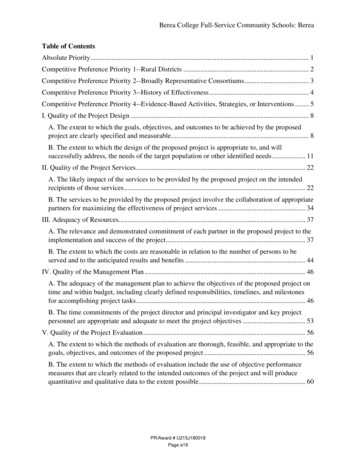
Transcription
Berea College Full-Service Community Schools: BereaTable of ContentsAbsolute Priority . 1Competitive Preference Priority 1--Rural Districts . 2Competitive Preference Priority 2--Broadly Representative Consortiums . 3Competitive Preference Priority 3--History of Effectiveness . 4Competitive Preference Priority 4--Evidence-Based Activities, Strategies, or Interventions . 5I. Quality of the Project Design . 8A. The extent to which the goals, objectives, and outcomes to be achieved by the proposedproject are clearly specified and measurable. 8B. The extent to which the design of the proposed project is appropriate to, and willsuccessfully address, the needs of the target population or other identified needs . 11II. Quality of the Project Services . 22A. The likely impact of the services to be provided by the proposed project on the intendedrecipients of those services . 22B. The services to be provided by the proposed project involve the collaboration of appropriatepartners for maximizing the effectiveness of project services . 34III. Adequacy of Resources. 37A. The relevance and demonstrated commitment of each partner in the proposed project to theimplementation and success of the project . 37B. The extent to which the costs are reasonable in relation to the number of persons to beserved and to the anticipated results and benefits . 44IV. Quality of the Management Plan . 46A. The adequacy of the management plan to achieve the objectives of the proposed project ontime and within budget, including clearly defined responsibilities, timelines, and milestonesfor accomplishing project tasks . 46B. The time commitments of the project director and principal investigator and key projectpersonnel are appropriate and adequate to meet the project objectives . 53V. Quality of the Project Evaluation . 56A. The extent to which the methods of evaluation are thorough, feasible, and appropriate to thegoals, objectives, and outcomes of the proposed project . 56B. The extent to which the methods of evaluation include the use of objective performancemeasures that are clearly related to the intended outcomes of the project and will producequantitative and qualitative data to the extent possible . 60PR/Award # U215J180018Page e19
Berea College Full-Service Community Schools: BereaAbsolute PriorityBerea College, Berea Independent School District and multiple community partners havedesigned and will implement this Full Service Community School program in three schoolsthat are eligible for schoolwide programs. Our consortium includes one LEA (BereaIndependent School) and multiple community-based and nonprofit organizations (SeeMemorandum of Agreement for detailed description) and thus meets the requirements to bean eligible entity.Our consortium, the eligible entity, will provide comprehensive services at three schoolsites and will provide services to the 1,092 students enrolled in these school sites as follows: Berea Independent Elementary School, preschool through 5th grade, 513 students; Berea Independent Middle School, 6th through 8th grade, 244 students; Berea Independent High School, 9th through 12th grade, 335 students.Our program is a district-wide program and includes all schools and students within the district.Berea Independent Schools qualifies for district wide, 100% free and reduced lunch, with 87% ofthe students living within the school district boundaries eligible for free or reduced-price lunch.Thus, the Berea Independent School District is eligible for schoolwide FSCS services.1 Ourconsortium, comprised of the eligible entity, and our partners, will focus our services only onschools eligible for a schoolwide program. Should the status of any of our three FSCS siteschange, we will immediately connect with the US Department of Education and address theimpact of the change.We have designed a Berea FSCS project that meets all the program requirements of aFull Service Community School, Figure 1.1PR/Award # U215J180018Page e20
Berea College Full-Service Community Schools: BereaFigure 1. FSCS Requirements Addressed within ProposalPage Numbers AddressingRequirementRequirementDescription of Eligible EntityMOU among all partners in the eligible entityCapacity of the eligible entity to coordinate and providepipeline services at two or more FSCSComprehensive Plan that includes:Student, family and school community to be served,including demographic informationA needs assessment that identifies the needs ofstudents, families and community residentsAnnual measurable performance objectives andoutcomes, including an increase in the number andpercentage of families and students to be targetedfor each year, in order to ensure that children are 1)prepared for Kindergarten, 2) Achievingacademically; and 3) Safe, healthy, and supported byengaged parentsPipeline services, including existing and additionalservices, to be coordinated and provided by theentity, including 1) why services have been selected;2) how services will impact student academicachievement 3)how services address the objectivesand outcomesPlans to ensure that FSCS site has:a full-time coordinator, a description of fundingsource for the coordinatorplans for professional development of staffplans for joint utilization and management of schoolfacilitiesPlans for annual evaluation based upon attainment of theobjectives and outcomesPlans for sustaining the programs and services beyond thegrant periodAssurance that the eligible entity and partners will focusservices on schools eligible for a schoolwide program1, 37-4337-42, Appendix C4, 8, 42-4511-1911-227-117, 22-367, 55-5648-4949-5055-6344-461Competitive Preference Priority 1--Rural DistrictsBerea Independent School District is eligible under the Rural and Low-Income School.Twenty-six percent of the children ages 5 through 17 years served by Berea Independent Schools2PR/Award # U215J180018Page e21
Berea College Full-Service Community Schools: Bereaare from families with incomes below poverty; and all the schools are designated with a schoollocale code of 32.2Competitive Preference Priority 2--Broadly Representative ConsortiumsOur consortium is a multi-sector representation of the organizations that support studentsuccess in our rural community. The consortium membership represents the following sectors:public schools, postsecondary education, health and mental health providers, financial servicesprovider, family engagement, out-of-school time and safety providers, and educational advocacyorganizations. The rural nature of our community means that the sectors represented may seemmore limited than you would find in an urban or suburban area. For example, no private orcharter schools serve students living in our rural community. We have no Boys and Girls Clubsor YMCAs within our community. No community foundation is focused on the success of Bereastudents and their families. Due to the rural nature of our community, many of our consortiummembers are regional or statewide organizations that provide services across a broad swath ofrural communities.Our consortium members include: Berea College (an institution of higher education) Berea Independent School District (a local educational agency) Appalachian Community Federal Credit Union (a nonprofit banking institution) Kentucky Center for School Safety (a statewide safety collaborative) KentuckyOne Health Foundation (a regional healthcare foundation) Kentucky Out of School Alliance (a statewide organization supporting out-ofschool time)3PR/Award # U215J180018Page e22
Berea College Full-Service Community Schools: Berea Prichard Committee (a nonpartisan advocacy organization and provider of familyengagement programs) White House Clinic (a healthcare organization)Additional information is provided on each partner in the Adequacy of Resources section onpage 37.Competitive Preference Priority 3--History of EffectivenessOur consortium members have a long history of working together to impact children andfamilies in Berea. In rural communities like ours, where there are few organizations working tosupport students and success, the organizations that do the work collaborate. A recent example ofeffective collaboration is the consortium’s success in securing a 21st CCLC program for BereaIndependent High School and a Striving Readers program for Berea Independent Elementary.The consortium designed these programs, prepared the grant applications and submitted theapplications. The applications were funded and the consortium is providing the vision andleadership for the work in anticipation of a fall launch of the programs. The partnershipdevelopment and collaboration required to design, submit and receive this funding will behelpful as we implement the FSCS program at three Berea sites. Most importantly, throughFSCS the consortium will have the ability to coordinate these programs and others into aseamless pipeline of services that will positively impact students and families.Another example of our consortium’s work is our collaboration around the GEAR UPcollege access and success program. Our work with GEAR UP has a larger footprint than FSCSand involves other school districts. However, the consortium’s local coordination of the GEARUP work was essential for program success. During GEAR UP 2005, from years 2005 to 2009,there was an increase of 17% in middle school students at or above grade level in math and a4PR/Award # U215J180018Page e23
Berea College Full-Service Community Schools: Bereagrowth in reading of 3%. Success was had in closing achievement gaps for low-income students,who are identified by their eligibility for free/reduced-priced lunch (FRPL). In 2004 (baseline),there was gap of 11% in math between FRPL students and non-FRPL students for our GEAR UPproject. By 2008, the gap decreased to 9%. In reading, the gap of 10% between FRPL studentsand non-FRPL students in 2004 narrowed to 8% by 2008.3Competitive Preference Priority 4--Evidence-Based Activities, Strategies, or InterventionsOur proposed FSCS is supported by promising evidence as defined by the USDepartment of Education. A key project component included in our logic model (Check andConnect) is informed by research and evaluation findings that suggest the project component islikely to improve relevant outcomes. More importantly, in addition to meeting the standardsrequired for promising this key project component of our design meets the more stringentdefinition of moderate evidence.In the context of federal education law and regulations, “evidence-based” means theproposed project component issupported by one or more oflevels of evidence with thefirst level of evidence beingthe most significant. Evidenceclassified as promising is the3rd level of evidence.Evidence that qualifies asmoderate is the 2nd level of evidence as illustrated above.45PR/Award # U215J180018Page e24
Berea College Full-Service Community Schools: BereaCheck and Connect, a key component within our logic model, meets the What WorksClearinghouse (WWC) standard required for promising and moderate evidence of effectivenessas follows in Figure 2:Figure 2. Check and Connect Satisfaction of Criteria for Meeting Promising EvidenceCriteriaWWC Review of Check and Connect StudiesBased on highTwo studies are randomized controlled trials that meet WWC groupquality research ordesign standards without reservations:positive evaluationSinclair, Christenson & Hurley, C. M. (1998). Dropout prevention forthat suchyouth with disabilities: Efficacy of a sustained schoolintervention is likelyengagement procedure. Exceptional Children, 65(1), 7–21.to improve studentSinclair, Christenson & Thurlow, M. L. (2005). Promoting schooloutcomescompletion of urban secondary youth with emotional orbehavioral disabilities. Exceptional Children, 71(4), 465–482.At least one studyTwo studies meet WWC group design standards:meets the WWC Sinclair, Christenson & Hurley, 1998Evidence Standards Sinclair, Christenson, & Thurlow, 2005without reservationsA statisticallyThe WWC review for the Dropout Prevention area includes studentsignificant favorable outcomes in the domain of staying in school as follows:impact on a relevant *The Sinclair (1998) study reported that 9th grade students in Check &outcome (with noConnect were statistically significantly less likely than similarstatisticallycomparison group students to drop out of school by the end of 9thsignificantgrade.unfavorable impacts *The Sinclair (2005) study reported Check & Connect students wereon that outcome for statistically significantly less likely to have dropped out at the end ofrelevant populations the 4th follow-up year.in the study or other *For the progressing in school domain, both showed statisticallystudies reviewed by significant positive effects, resulting in an improvement index of 30.and reported on by*For the staying in school domain, both studies showed statisticallythe WWC)significant positive effects, resulting in an improvement index of 25.Result: WWC rating of positive effects, with small extent of evidenceIncludes a matchedCheck and Connect Study Populationssample that overlaps *Included 238 students who attended Minneapolis high schoolswith the populations & entered program in the beginning of 9th grade.or settings proposed *Included students receiving special education services.to receive theOur Mentoring Program Populationthprocess, product,*Includes rising 9 grade studentsstrategy, or practice. *Includes students receiving special education services.Our rationale is demonstrated by our logic model, which follows:6PR/Award # U215J180018Page e25
Berea College Full-Service Community Schools: Consortium,SiteCoordinatorsConsortiumdedicated toimprovedcoordination,integration,accessibility, andeffectiveness ofservices forstudents andfamiliesPipeline ofServicesdesigned toaddresscommunity needISS Frameworkand ResearchBased PracticesOutputsIntermediate OutcomesEarly Childhood Programs: Parent engagement;Professional Development; Reading programsLong-Term 25% increase in the number ofKindergarten students who areready for KindergartenFor FSCSStudents,Families andFSCS sites: Transition Programs: AmeriCorps; GEAR UP;Parent programs; Career Fairs; Financial aid info;Job shadowing; College visits; Check and Connect20% increase in the number ofstudents scoring proficient in mathMore childrenprepared forKindergarten Family and Community Engagement: Financialliteracy; Parent leadership; statewide advocacy;Teacher PD; Prichard sessions; referrals to services40% increase in the number ofstudents scoring proficient inEnglish Postsecondary and Workforce Readiness:Internships; AmeriCorps; GEAR UP; Dual Credit;credentialing; mentoring; parent outreach20% increase in the number ofstudents who graduate high schoolprepared for college 15% increase in the number ofhigh school students who aresupported in their college andcareer planning by their parentsSchool and Out-of-school Time: ExtendedLearning Opportunities/21st CCLC; tutoring;GEAR UP; AmeriCorps; Test prep; mentoringCommunity-based Support for Students: GEDclasses; credentialing; personal budgeting, ACFCUfinancial literacy, workforce readiness Social, health, nutrition, and mental healthservices: White House Clinic, Health/wellnessprograms; nutrition; school safety; mental healthreferrals; Green Dot; feeding programs 25% increase in the number ofstudents feeling safe at school25% increase in the number offamilies referred to servicesJuvenile crime prevention: Center for SchoolSafety PD for teachers; presentations to students;Check and Connect mentoring; parent outreach7PR/Award # U215J180018Page e26More studentsachievingacademicallyMore studentswho are safe,healthy, andsupported byengaged parentsIncreasedcoordination ofservices tostudents andfamiliesAll Berea studentssucceed at School
Berea College Full-Service Community Schools: BereaI.Quality of the Project DesignA. The extent to which the goals, objectives, and outcomes to be achieved by the proposedproject are clearly specified and measurableOur consortium developed Berea Full Service Community School (Berea FSCS) to meet theneeds of the students and families in rural Berea, Kentucky. Berea College, the lead applicant, isin its last year of successfully implementing a Full Service Community School program in ruralKnox County, Kentucky (Knox FSCS). Several of the Berea FSCS consortium were activelyengaged in the Knox FSCS project. The Berea FSCS consortium has reviewed information fromKnox FSCS, talked with the program’s staff and has learned from their experience. Knox FSCSwas successful. Each year, Knox FSCS met and significantly exceeded the program’s GPRAmeasure related to the percentage of students and families targeted for services that receiveservices, annually. For the 2018 annual performance report, Knox FSCS served an unduplicated94% of its target population. Knox FSCS met academic achievement performance measures inboth math and in English with a 26.7% improvement in math and 26.9% in English as measuredby Kentucky’s student assessment. The consortium is building Berea FSCS on the foundation,the lessons learned and the practices of Knox FSCS.Like the work in Knox FSCS, our program design is influenced by the Coalition forCommunity Schools’ research and their results framework.5 The Berea FSCS consortium willcollaboratively work toward the result that All Berea Students Succeed at School and hasestablished objectives and performance measures to measure progress toward this result (Figure3). Our logic model, page 7, illustrates our theory of change.Figure 3 illustrates the goals, objectives and outcomes to be achieved by our project. Ourspecific performance measures will ensure that we are on track to achieve each objective. Duringthe first quarter of implementation, our project director, partnership councils and evaluator will8PR/Award # U215J180018Page e27
Berea College Full-Service Community Schools: Bereawork to establish baselines in the areas where they are needed and will set annual targets for eachperformance measure to ensure that we are on track for achieving the objectives by the end of theproject period. Baseline data was established using the best available data at the time of theneeds assessment.Figure 3: Goals, Objectives and OutcomesObjectivesBaseline Data for ObjectiveOutcome Performance MeasuresGoal 1: To increase the number and percentage of children prepared for kindergarten.Obj 1.1: 25% 2017 – 2018 BaselinePM 1.1.1: #/% students and #/% of parentsincrease inBrigance, Kindergartenparticipating in transition to K programsthe numberReadinessPM 1.1.2: #/% students at kindergartenof studentsreadiness on Brigance 53.4% (39 students) ofready forstudents not readyKindergarten.Goal 2: To increase the number and percentage of students achieving academically.PM 2.1.1: #/% of students participating inObj 2.1:2016 – 2017 Baseline20% increase K-PREP Math #/% Proficientmath tutoring, test prep, and other academicin theor abovesupport activitiesnumber ofPM 2.1.2: #/% of students and #/% of 31.9% (87 students)studentsfamily members who participate inElementary studentsscoring 29.5% (72 students) Middle programs focused on transition -proficient inelementary to middle, middle to high, highschool studentsmath.to college and careerEOC Alg. II, #/% Proficient orPM 2.1.3: #/% chronically absent studentsabovereceive mentoring, supportive services 26% (27 students) ofPM 2.1.4: #/% at Proficient or above inAlgebra II studentsmath on Kentucky assessmentPM 2.1.5: #/% at Proficient or above inAlgebra II end-of-course examPM 2.2.1: #/% of students participating inObj 2.2:2016-2017 Baseline40% increase K-PREP Language MechanicsEnglish tutoring, test prep, and otherin the#/% Proficient or aboveacademic support activitiesnumber ofPM 2.2.2: #/% of students and #/% of 36.4% (32 students)studentsparents participating in programs focusedElementary studentsscoring 38.4% (33 students) Middle on transition -- elementary to middle,proficient inmiddle to high, high to collegeSchool studentsEnglish.EOC English II, #/% Proficient PM 2.2.3: #/% chronically absent studentsreceive mentoring, supportive servicesor abovePM 2.2.4: #/% Proficient and above in 53% (48 students) EnglishLanguage Mechanics on state assessmentII studentsPM 2.2.5: % at Proficient and above inEnglish end-of-course exam9PR/Award # U215J180018Page e28
Berea College Full-Service Community Schools: BereaFigure 3: Goals, Objectives and OutcomesObjectivesObj 2.3:20% increasein number ofstudents whograduate highschoolprepared forcollege.Baseline Data for ObjectiveOutcome Performance MeasuresPM 2.3.1: % of students at/aboveBaseline: 2016-17ACT Math, #/% at benchmarkbenchmark on ACT in English and in MathPM 2.3.2: #/% of students and their 43% (37 students) atfamilies who participate in transition frombenchmark in math)HS to college activitiesACT English, #/% atPM 2.3.3: #/% of disconnected youth whobenchmarkare re-connected to school 52.3% (45 students) atPM 2.3.4 #/% of youth who reenter schoolbenchmark in EnglishAFGR Graduation rate, #/% of from juvenile justicegraduates 81% (87 students) graduateon timeCollege Readiness, #/% of highschool graduates 45% (39 students) of highschool graduates do notgraduate college readyGoal 3: To increase the number of students that are safe, healthy, and supported byengaged parents.Baseline: Will be establishedPM 3.1.1: #/% of parents participating inObj 3.1:15% increase during first quarter of FSCScollege and career planning activitiesin number of program via a survey to all high PM 3.1.2: #/% parents who completehigh schoolschool students.FAFSAstudentsPM 3.1.3: #/% students reporting, viasupported insurvey, feeling supported by parentscollege andPM 3.1.4: #/% of students and #/% ofcareerfamily members who participate inplanning byprograms focused on transition from hightheir parents.school to college and careerObj 3.2: 25% Baseline: Will be establishedPM 3.2.1: #/% of students who reportincrease induring first quarter of FSCShaving an adult to talk to about concernsthe numberprogram via a survey to all high PM 3.2.2: #/% of students and #/% ofof studentsschool students.family members who participate infeeling safeprograms focused on transition fromat school.elementary to middle school and frommiddle school to high schoolPM 3.2.3: #/% chronically absent studentswho receive mentoring, supportive servicesPM 3.2.4: #/% of disconnected studentswho are reconnectedPM 3.2.5: #/% of students who feel schoolis a safe place10PR/Award # U215J180018Page e29
Berea College Full-Service Community Schools: BereaFigure 3: Goals, Objectives and OutcomesObjectivesObj 3.3: 25%increase inthe numberof familiesreferred toservices.Baseline Data for ObjectiveBaseline: Will be establishedduring first quarter of FSCSprogram via a survey to all highschool students.Outcome Performance MeasuresPM 3.3.1: # of programs at FSCS forfamily membersPM 3.3.2: #/% of families who participatein FSCS programsPM 3.3.3: #/% of families referred toservicesIn addition to establishing annual measurable performance objectives and outcomes, wehave established measurable outcomes for the increase in the number and percentage of familiesand students targeted for service each year of the program in order to ensure that our three goalsare met, Figure 4. Our outcomes were based on: 1) our experience successfully implementing aFull Service Community School program in rural, Appalachian Knox County Kentucky that wasof similar scope and size; 2) the number and percentage of students living within the schooldistrict boundaries that qualify for free and reduced lunch (87%), and; 3) the needs assessmenthighlighting the gaps and weaknesses in services to students and families.Figure 4. Number and percentage of families and students targeted each year for servicesNumber and Percentage of Students and Families to be ServedEach Year by FSCSBaseline#/%#/%#/%#/%#/%2017-18 Year one Year Two Year Three Year Four Year Five1092 799 (75%) 841 (77%)863 (79%) 885 (81%) 907 (83%)StudentsFamily1092 437 (40%) 459 (42%)481 (44%) 502 (46%) 525 (48%)MemberB. The extent to which the design of the proposed project is appropriate to, and willsuccessfully address, the needs of the target population or other identified needsThere are many tough places in this country: the ghost cities of Detroit,Camden and Gary, the sunbaked misery of inland California and the isolatedreservations where Native American communities were left to struggle. But inits persistent poverty, Eastern Kentucky—land of storybook hills and drawls—just might be the hardest place to live in the United States. Statisticallyspeaking.Annie Lowery, “What’s the Matter with Eastern Kentucky?”New York Times, 6/29/201411PR/Award # U215J180018Page e30
Berea College Full-Service Community Schools: BereaFrom January–April 2018, consortium members reviewed school plans, ACT and stateassessment data, community level data and student and parent survey data; and interviewedcommunity members, administrators, counselors, and teachers. From this comprehensive needsassessment, we have identified the needs, gaps and weaknesses in services that will be addressedin our Full Service Community Schools project design.Community Level DataTo fully understand the students we serve, one must understand the challenges of ruralAppalachia. Of the poorest 250 counties in the United States, 244 are rural. One in four ofAmerica's public schools are rural. One in five poor children in this country live in a rural area.6The Forgotten Fifth: Child Poverty in Rural America, notes that this group of vulnerable youngAmericans is seldom on the minds of the public or policy makers when they talk about childpoverty in the United States:Rural poverty is widespread and diverse. Rural poverty encompassesimpoverished rural hollows in the Appalachian Mountains, formersharecroppers’ shacks in the Mississippi Delta, and desolate Indianreservations on the Great Plains. The lack of a single image of rural povertymakes it more difficult to describe and discuss.7Our community puts a face on rural poverty and emphasizes the dire need forincreased services to students in rural Appalachia. Poverty levels are high; educationalattainment and income are low, all exacerbated by the rural nature of the area. Economic andeducational problems are deeply embedded. The Appalachian Regional Commission (ARC)created an index of county economic status that ranks all counties in the nation. The index, basedon three-year average unemployment rate, per capita market income, and poverty rate, ranksMadison County, where Berea is located, in the bottom 37% of all counties in the nation.8 Bereais the most distressed area within Madison County. A distressed area is one that ranks in the12PR/Award # U215J180018Page e31
Berea College Full-Service Community Schools: Bereabottom 10% of all areas in the nation. ARC has designated one census tract in Madison Countyas distressed, and that census tract is within the city of Berea and that tract encompasses roughly30% of Berea Independent School District’s territory. Figure 5 contains socio-economicinformation for Berea.9Figure 5. Socio-Economic Information for the CommunityRegion% of Below PovertyPer Capita Income% US Poverty RateBerea FSCS22% children, 15% families 22,271141%Nation21% children, 11% families 29,829100%Persistent childhood poverty, like the poverty experienced in our rural Appalachiancommunity, has been linked to academic failure, school dropout, and reduced rates of collegeattendance and graduation.10 Students living in poverty, on average, start their educationalexperience significantly behind their peers in terms of the precursor reading and mathematicsskills and the knowledge they bring to school. Differential experiences during the summersbetween grades widen these gaps. As they grow older, students in poverty tend to have lessacademic background knowledge and more limited vocabularies, which further challenge thepace with which they read and absorb academic material.11Our community is under-educated. Twenty-nine percent of the residents of MadisonCounty have a bachelor’s degree or higher.12 These adults are the caretakers for our children andour youth.Our rural parents do not have the information necessary to assist their children witheducational planning including financial planning for college. Contrary to popular stereotypesdepicting Eastern Kentucky parents who d
Berea College Full-Service Community Schools : Berea 1. Absolute Priority. Berea College, Berea Independent School District and multiple community partners have designed and will implement this Full Service Community School program in three schools that are eligible for schoolwide programs . Our consortium includes one LEA (Berea
